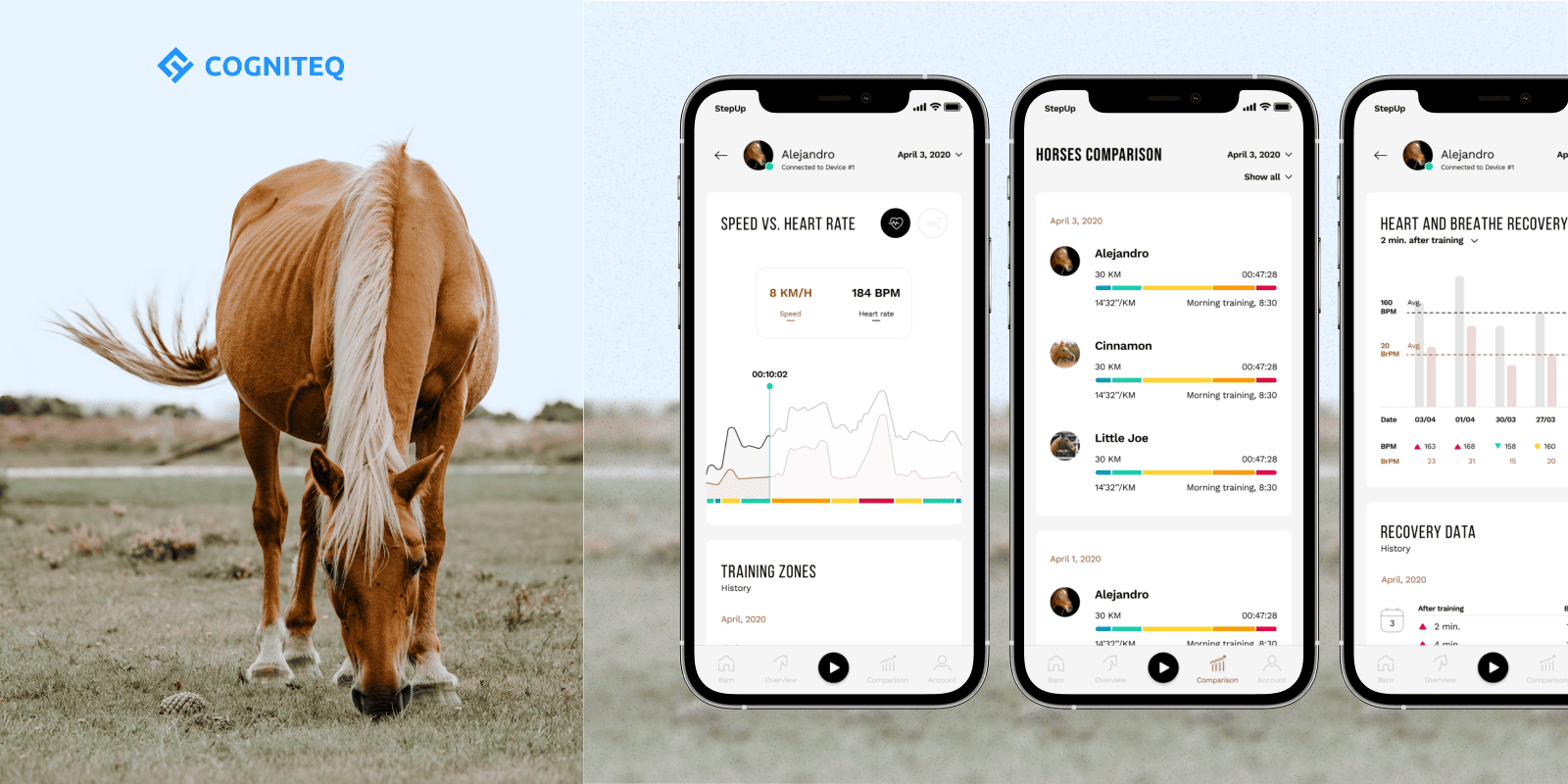The general purpose of wearable technology is to produce data and analyze it while the wearer is performing some kind of action, be it working, jogging, or sleeping. Typically, a wearable tech solution includes a device with a sensor, a cloud, and a user-facing app. The device generates relevant chunks of data and sends them to the cloud which acts as data storage. This data is then transformed into insights that the user app visualizes.
The devices may take many forms, from common smartwatches and fitness trackers to more advanced rarities embedded in fabric or accessories or tattooed directly onto the skin.
What is wearable technology in sports?
Wearable technology in sports refers to electronic devices worn by athletes that collect and transmit data related to their physical activity, performance, and health.
Arguably, no other industry benefits more from wearable tech than the sports industry. With the help of advanced sensors, athletes and their coaches can gather data on everything from heart rate to acceleration, and use this information to create more effective training plans, identify weaknesses in their sports performance, and track their progress toward fitness objectives.
Wearables are used both during training and in competition to gain insights and improve outcomes.
Examples of wearable technology in sports
The examples of wearable technology in sports are plentiful. Heart rate monitors track breathing and pulse patterns. Gyroscopes and accelerometers track location, rotation, speed, and other crucial parameters for American football pitchers, quarterbacks, and other positions. GPS, which we described as one of the pillars of sports tech, tracks distance and velocity parameters for cyclists and runners. Sleep monitors aid athletes in recovering and customizing their sleeping patterns.
As a more sophisticated use case, athletes can even participate in VR training sessions on their TVs - all they need to do is place sensors in their room and on their feet.
How wearable technology is changing sports
Sports wearable devices didn’t only change how individuals approach their training, they changed the whole industry. We’ve already talked about how IoT reshapes the fitness industry, but competitive sports is another story altogether. Today's referees across many sports and competitions use wearable technology to make better informed decisions. In association football, goal-line technology and video assistant referee (VAR) aid officials in making the right calls and maintaining control of the game. For instance, in situations where it's impossible to tell with the naked eye if a ball crossed the goal line, sensors and smartwatches are used to confirm the situation.
To understand the value of such devices for the industry, it’s worth looking at how wearable technology in sports improves athletic performance. Sensors can offer vital data even during the game. A player's speed, distance traveled, and acceleration can all be tracked in real time using RFID chips or GPS trackers sewed into their kits. This data can be used by coaches to make important in-game decisions. For example, if a coach sees that a player traveled a lot, they may consider making a substitution. And after the game, the data is used to analyze the match not only by coaches, but also by fans and pundits on television.
Finally, with wearable technology in sports, early indications of soft tissue damage can be quickly identified, allowing coaches to tweak athletes’ training programs. Potential concussions, brain trauma, overexertion, torn muscles and ligaments can all be foreseen with the help of impact monitor stickers.
Benefits of wearable technology in sports
Some of the major benefits that one can get from using sports wearable devices are as follows:

- Improved Performance - naturally, the devices themselves will not grow muscles for you, but they will provide you with a lot of invaluable data that you can monitor overtime and adjust your training for better effect;
- Improved Coaching - if you are a coach, you can utilize wearable tech to come up with most advanced training programs and become a top level professional;
- Improved Health - keeping track of your vitals such as heart rate or sleeping patterns will help you understand your body and its needs better, leading to a healthier lifestyle;
- Lower Injury Risk - a number of wearable devices can track such metrics as tissue damage, allowing sportspeople to take preventive measures and not get injured as a result of a training overload;
- Community Access - software paired with wearable devices often also allows you to connect with other users; you can find someone near you to do training together, compare each other’s metrics and compete with each other.
The role of AI in wearable sports tech
Artificial intelligence (AI) is revolutionizing wearable technology in the sports industry by enabling real-time, data-driven insights that enhance athlete performance and safety. Modern wearable devices equipped with AI algorithms analyze biometric data such as heart rate, movement patterns, and physiological stress to provide personalized training recommendations. This allows athletes and coaches to optimize workouts, monitor recovery, and prevent injuries through early detection of fatigue or strain. AI-powered athlete monitoring systems are becoming essential tools in maximizing performance while reducing injury risks.
AI’s capability to personalize training regimes based on individual data sets is transforming how athletes prepare and compete. By continuously learning from an athlete’s performance metrics, sleep quality, and even mental state, AI-powered wearables can suggest tailored adjustments to training intensity and rest periods. This dynamic adaptation, often supported by advanced GPS tracking technology, helps maximize results while minimizing the risk of overtraining, which is critical for professional athletes and teams striving for peak condition.
Beyond physical metrics, AI integration extends to cognitive and neurological monitoring. Advanced sensors can track brain activity and stress levels during training or competition, offering a comprehensive view of an athlete’s mental readiness. Such insights are increasingly used to fine-tune mental conditioning and game strategies, ensuring athletes maintain focus and resilience under pressure.
Overall, AI in wearable sports technology is not only elevating athletic performance but also deepening our understanding of the complex interplay between physical and mental factors in sports. This synergy opens new frontiers in sports science, enabling smarter training, better health management, and ultimately, higher levels of competitive achievement.
A powerful sports app - for your training needs?
Brilliant idea! Our experts will help your sports organization perform better than ever on and off the field!
Cogniteq’s experience in wearable tech for sports
Our team closely monitors all wearable sports tech trends to make sure that our custom products will bring the highest value to sportspeople with different needs. For instance, we’ve developed a power metering app for cyclists for TeamZWATT.
Power meters are devices that measure the rider's power output in watts (W). This information is vital for both professional and recreational cyclists, as it helps with performance monitoring. TeamZWATT already collaborated with top bicycle manufacturers and brands, supplying their bikes with power meters; and they wanted to develop their own app for gathering and analyzing sensor data.

They’d already had an Android app, but it needed much improvement. Our team was asked to develop two different apps for Android, using the existing app as a core. One app was purely for the TeamZWATT brand, whilst the other was created for their business partner who would be selling products to a different client base. App user interface and functionally also varied. On top of that, we created another pair of apps for iOs, replicating the ones for Android.
One more example of our team’s wearable tech expertise would be an IoT app for horse monitoring - StepUp Horse.
We were asked to build an Android app to pair with a wearable device planted on racehorses' thorax. The device tracked such racehorse’s vitals as respiration and heart rate as well as distance traveled and speed during training sessions.

We created a feature-rich IoT-powered app that enabled owners and trainers to access training records and data statistics on their smartphones and track data in real-time via a smartwatch. To update wearables' firmware, the app uses the Nordic Semiconductor DFU library. It establishes a Bluetooth connection with each device, determines the firmware version, downloads the most recent version that is currently accessible, and starts the update procedure.
Final thoughts
Wearable technology in sports has massively boosted the development of both individual sportspeople and the sports industry in general. From monitoring basic vitals such as heart rate to predicting tissue damage risks, wearable tech has a lot to offer to casuals and professionals alike. Devices improve athletic performance, coaching techniques, health conditions, and enable sportspeople to connect with like-minded individuals. And if you are thinking of integrating an app to make the most out of your data, get in touch with a team of professionals like Cogniteq.
FAQ
Why is wearable technology important in the sports industry?
With sports wearable devices, athletes and their coaches can receive a lot of data on everything from heart rate to acceleration and utilize it to come up with more efficient training plans, identify their weaknesses, and track their progress toward their fitness goals.
How does wearable technology improve athletic performance in 2025?
In 2025, wearable technology leverages advanced sensors, AI-driven analytics, and integrated smart sportswear to enhance athletic performance at every level. Devices now track detailed metrics such as muscle oxygenation, lactate threshold, biomechanics, fatigue, hydration, and sleep quality. With real-time feedback and predictive AI, athletes receive personalized training plans and virtual coaching tailored to their physiology. Smart textiles and wearable systems enable continuous monitoring and data-driven adjustments during training and competition. Critically, this tech supports safer training practices through injury prevention by detecting early biomechanical stress or fatigue indicators before they evolve into serious issues.
Are wearable devices used in professional sports?
Yes, today, wearables are widely used for health and performance analysis in sports. Such devices can track different metrics, including heart rate, distance, speed, and body temperature. Athletes and coaches can use the data to enhance training and recovery strategi
What are the benefits of wearables for coaches and teams?
Wearable devices provide real-time data that can help coaches effectively tailor training programs to athletes’ individual needs. They enable teams to monitor workload, fatigue, and biomechanics. With this data at hand, they can enhance performance and prevent overtraining. Apart from this, coaches can make informed decisions during games based on live data.
Can wearable tech help reduce injuries in sports?
Yes, wearable devices for athletes can play a significant role in injury prevention. They are designed to monitor stress levels, movement patterns, workload, and other parameters. Based on this data, wearables support effective load management by detecting early signs of strain or imbalance. This ensures timely intervention and adjustments in training, which is essential for preventing injuries.
How is data privacy managed with wearable sports tech?
To maintain data privacy in wearable sports tech, it is highly recommended to introduce such measures as secure data storage, encryption, and strict access controls. Also, sports clubs and organizations often implement additional policies to protect the personal and performance data of their athletes.























































